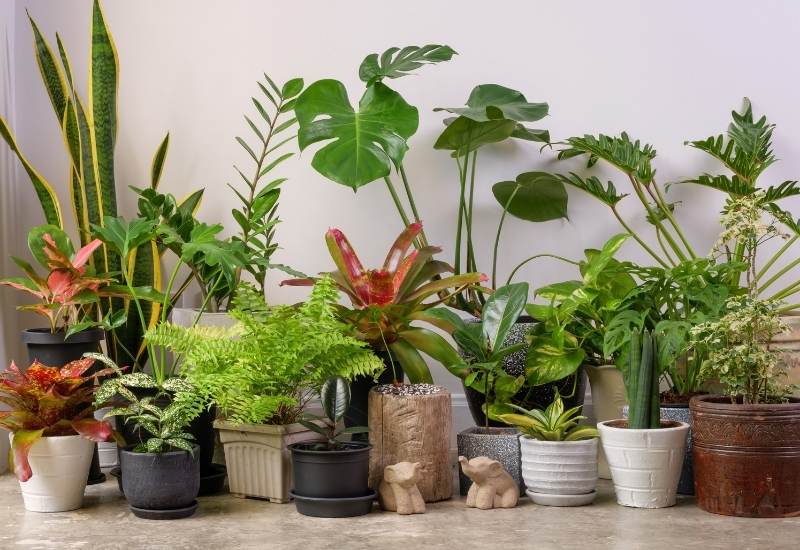
Native to the rainforests of Central and South America, tropical houseplants with an exotic look take us on a journey around the world where scents and colors intertwine with the beauty of shapes.
However, you don’t need to cross the South Seas to appreciate the beauty of these plants since many of these tropical plants can be easily grown indoors! Even if you live in the heart of winter.
Whether standing on the floor, hanging from shelves and hanging baskets or draped on windowsills – green and flowering indoor plants from tropical rainforests give your home the look of an exotic jungle.
Usually appreciated for their majestic size, amazing, often glossy, and colorful foliage, but many of these flowering tropical species will produce brightly colored and intoxicating fragrant blooms indoors.
While a few of these exotic beauties don’t survive long as houseplants because they make special demands on their environment, but most tropical plants have a certain adaptability that allows them to thrive in less than ideal environments.
Bromeliads, flamingo flowers, orchids, tropical ferns, palm trees, monstera and philodendrons are some of the most magnificent tropical plants you can grow indoors. These low-maintenance exotic beauties make excellent houseplants because they enjoy warm temperatures, average humidity, and moderate light—the typical conditions of indoor spaces.
So, to choose the best one for your space, you need to know what “presence” it has in your living room or study and the specific care it likes.
To make things a bit easier, I’ve rounded up the 15 most beautiful and exotic looking tropical plants to keep indoors, along with tips on how to keep these beauties thriving to bring that tropical vibe into your living space that you dream of.
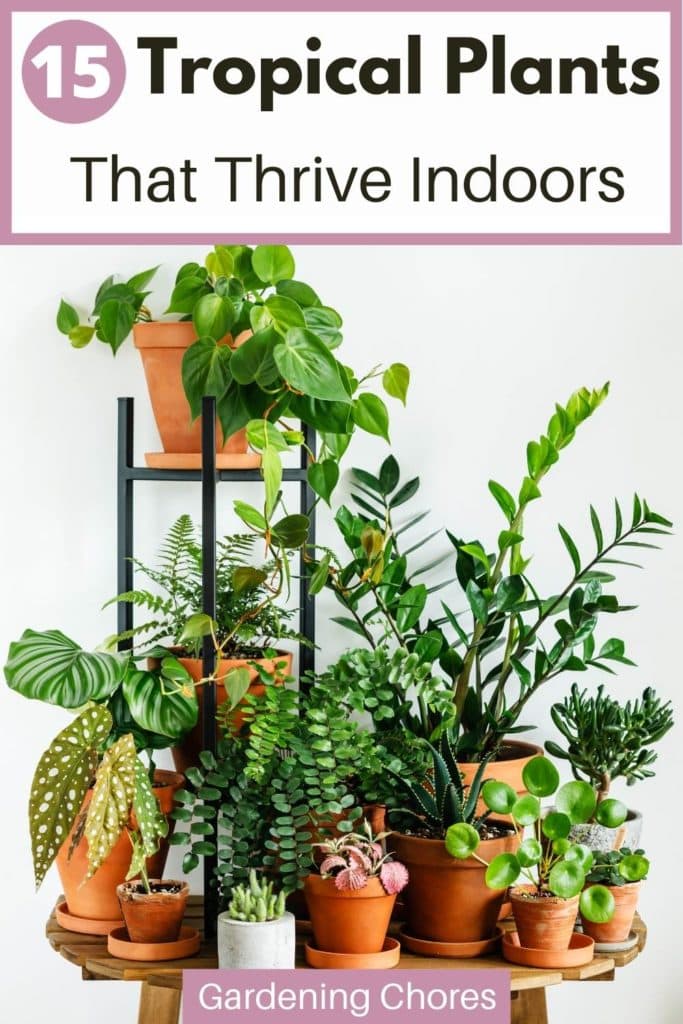
15 Tropical Houseplants You Can Grow Indoors
Here are 15 of our favorite hard to kill, easy to care for tropical houseplants to add a some exotic touch of the rainforest to your living room, kitchen, or even bathroom.
- Horsehead philodendron
- Moth orchid
- Golden pothos
- Croton ‘Mammi, a.k.a. Rainbow Croton
- Philodendron ‘Prince Orange’
- Baby Rubberplant
- Butterfly plant, a.k.a. swallowtail
- Red coral
- Living stones
- Madagascan palm
- Silver vase bromeliad
- New Guinea shield, a.k.a. hardy elephant’s ears
- Fiddle leaf fig
- Golden cane palm
- Thatch palm
… and trust me, you will be amazed when you get to know them, and see them – which is right now!
1. Horsehead Philodendron (Philodendron Bipennifolium)
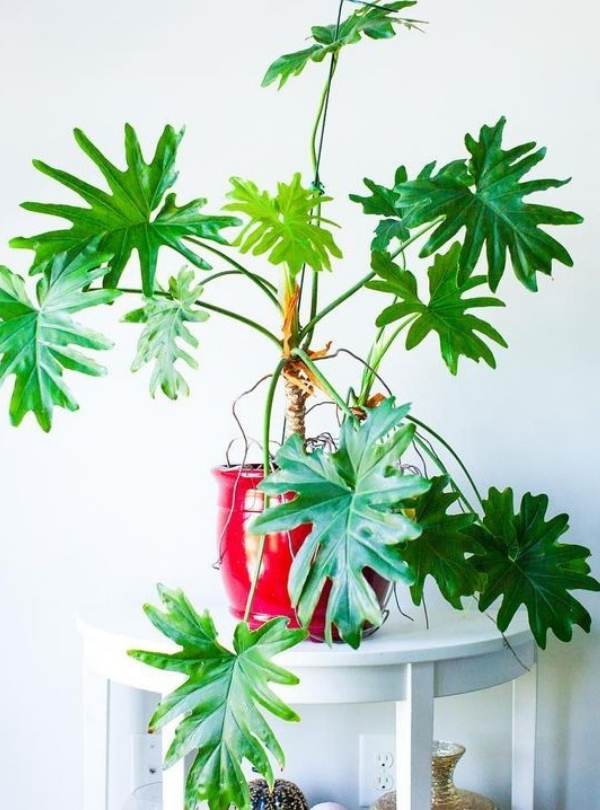
Horsehead philodendron is a stunning easy to grow tropical houseplant with large, emerald green segmented leaves. These are very shiny and with a waxy texture, and they grow horizontally on almost vertical individual stems.
It is perfect for a large space, and very sculptural indeed. Give it a prominent place in your living room or in a large office if you want to make the best of this exotic plant.
Philodendron is a classic houseplant. It is a large genus of 489 species, all with large, shiny and very decorative leaves. This makes them perfect for indoor spaces.
There are many sizes and shapes to choose from, and they like warm and humid places. But they are more than just “beautiful” indoors: they are excellent air purifiers.
2. Moth Orchid (Phalaenopis spp.)
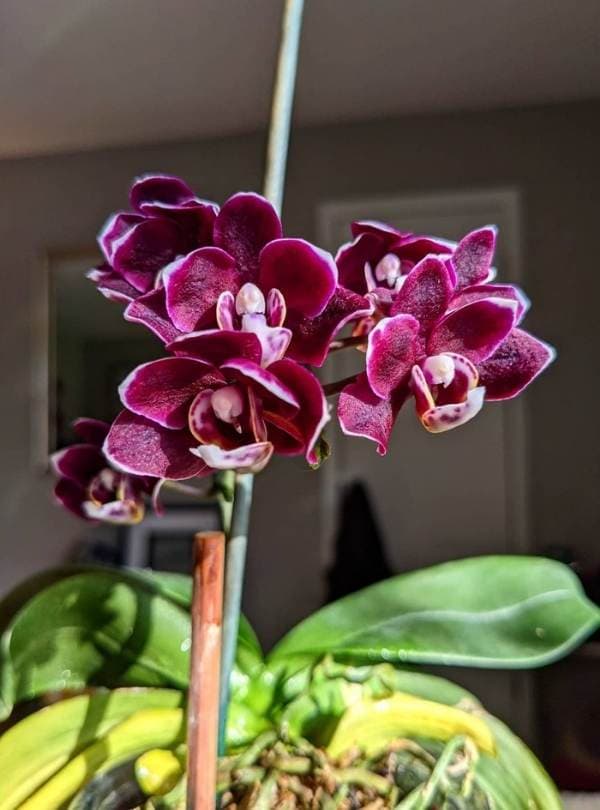
Another classic tropical houseplant is the now ubiquitous moth orchid. By far the most common orchid in the world, it is famous for its long lasting blooms, which can go on for months.
The flowers are strikingly exotic, of many bright colors, and the quintessence of elegance. What is more, moth orchids are low maintenance, and they can survive (and blossom!) even in fairly dark places. So, they suit many indoors spaces.
There are 70 species and a huge range of cultivars and varieties to choose from. And you can fund them even in supermarkets and non specialized stores!
3. Golden Pothos (Epipremnum Aureum)
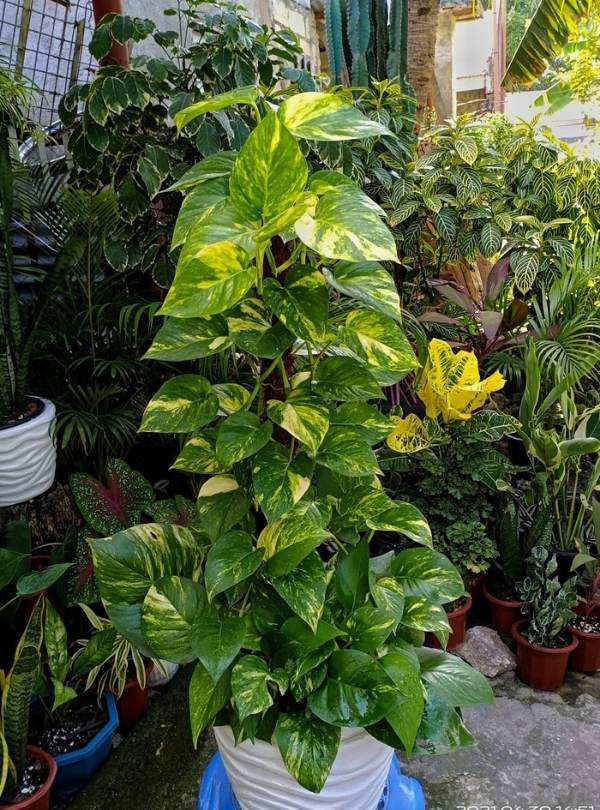
Golden pothos is yet another easy to care for tropical foliage houseplant you can grow indoor. It too is excellent to purify air. It is a vine with beautiful heart shaped leaves of two colors, green and – of course – gold.
It is so undemanding that people usually even forget about it. And it is forgiving.In fact it can even resist moderate draught, or, if you want, many people just grow it in a jug of water.
It is perfect for hanging baskets or to drape a shelf or cupboard; it is in fact a trailing plant. You can propagate simply and with high success rate with simple cuttings.
4. Croton ‘Mammi’, a.k.a Rainbow Croton (Codiaeum variegatum ‘Mammi’)
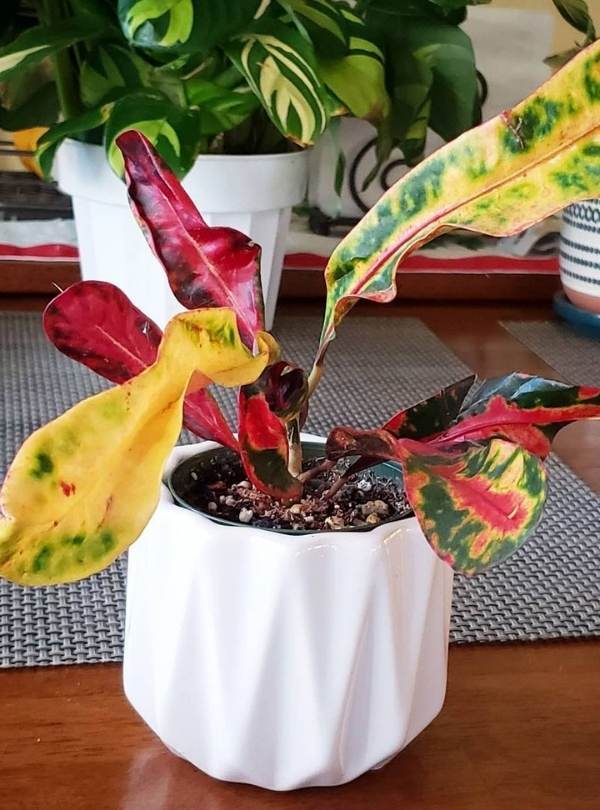
Rainbow croton, or croton ‘Mammi’ is an exceptional houseplant. Croton is fairly common, but this cultivar is spectacular! It has long, shiny and waxy leaves that wave a bit at the sides..
Ok, but why is it called “rainbow”? The colors of this plant are almost hallucinatory! The brightest green, yellow, red and burgundy purple mix in large patches and mark the central rib of the amazing leaves of this plant! Hold on! Some plants even have deep blue parts! Just amazing!
The leaves are so shiny that they reflect a lot of light, which enhances the impressive effect of this plant.
Of course, this is a prima-donna! It will look great as an energetic centerpiece, maybe on a beautiful table, or on (in) a fireplace…
5. Philodendron ‘Prince of Orange’ (Philodendron ‘Prince of Orange’)
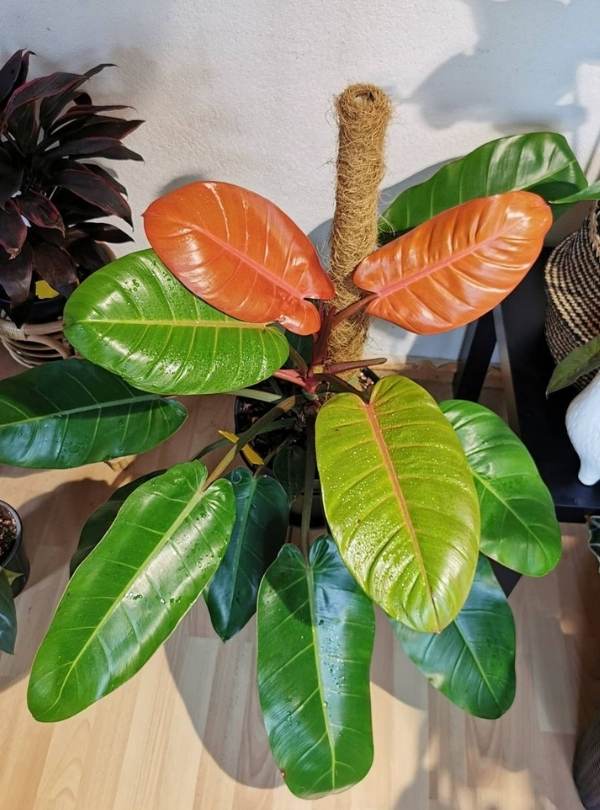
Philodendron ‘Prince of Orange’ is a sculptural, elegant and at the same time vibrant exotic houseplant. It has big and broad elliptical leaves that come individually at the end of a single stalk, regularly arranged.
They are pointed and very shiny. But some are green, while others are of the most striking and convincing copper color ever!More than as a houseplant, you should treat philodendron ‘Prince of Orange’ as a living sculpture.
It is so elegant, the surface if the leaves is so “marble smooth” and the colors so “modern” this bold plant needs a pedestal in the center of a very clean but artistic room to give its best. A museum piece, basically.
6. Baby Rubberplant (Peperomia obtusifolia)
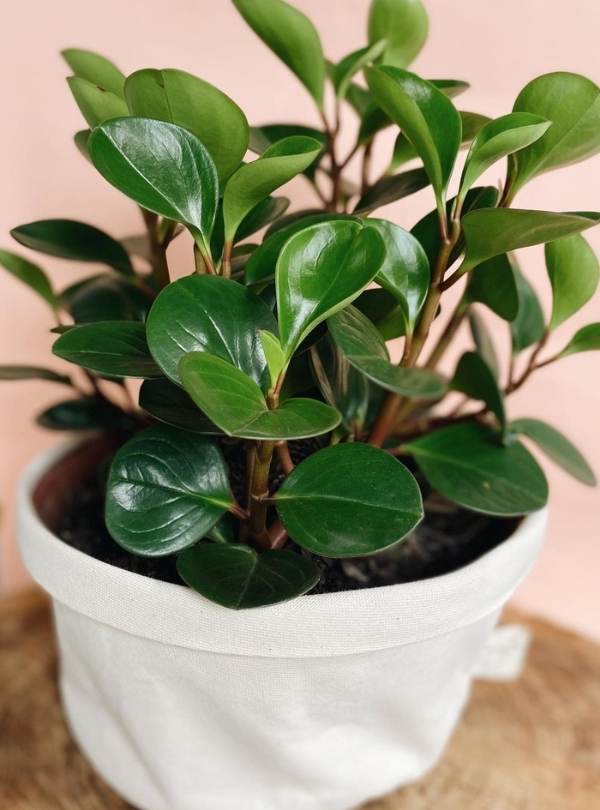
Baby rubber plant, or pepper face, is an original, playful but also elegant tropical houseplant you can grow indoors. It has very round leaves of the deepest emerald green you can find.
They look and feel like rubber, and this is why it has this name.It grows well indoors and in warm countries also outdoors. It can look great on a work desk, where it can add a decorative touch while at the same time lighten the mood with its playful look.
It is also great for children, who seem to love this plant very much. Keep the foliage clean, wiping it wit a wet cloth regularly for best effect.
7. Butterfly Plant, a.k.a. Swallowtail (Christia obcordata)
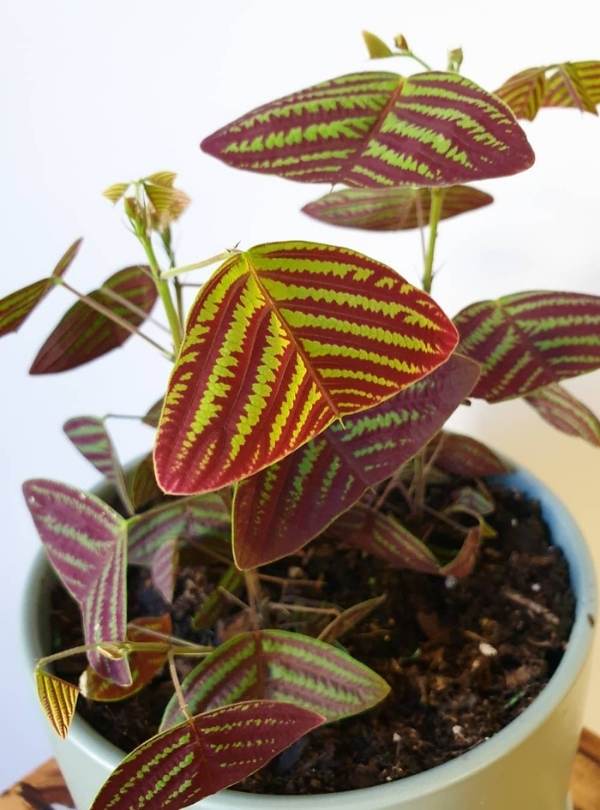
For an unusual, lesser known and original tropical houseplant, look at butterfly plant. It is called so because it has very strange foliage. The leaves are divided into two almost triangular sections with a central rib.
Then, curved red, brown or purple stripes run from the central rib to the edges, across the bright green leaves, or sometimes blue leaves. This makes them look like butterfly wings.
These butterfly wings will appear in thin upward stems, and look like they are flying in the air!It’s a delicate looking little plant that looks great in small clumps, maybe even mixed in with other tropical houseplants.
Perhaps its best utilization would be in a beautiful terrarium that reproduces an imaginative landscape on your coffee tabl
8. Red Coral (Rhipsalis ramulosa)
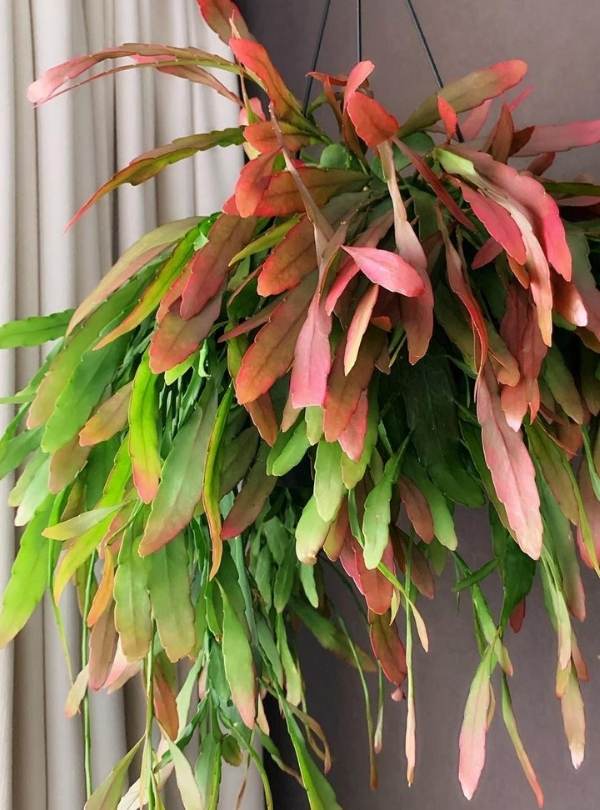
For an exotic houseplant with a very original personality, red coral is perfect. It is a trailing beauty with long, dented purple red leaves.
These come on arching stems, and they look at the same time very decorative and rebellious, while keeping the exotic lushness of exotic plants.
In fact, despite the shrub like look of this plant, it is actually a succulent and a member of the cactus family!It is an excellent plant for fairly large hanging baskets.
If you have a conservatory, or other well lit room where you want some vibrant foliage to hang above your head, red coral is a very original choice indeed. Another idea may be to grow it on high shelves.
9. Living Stones (Lithops spp.)
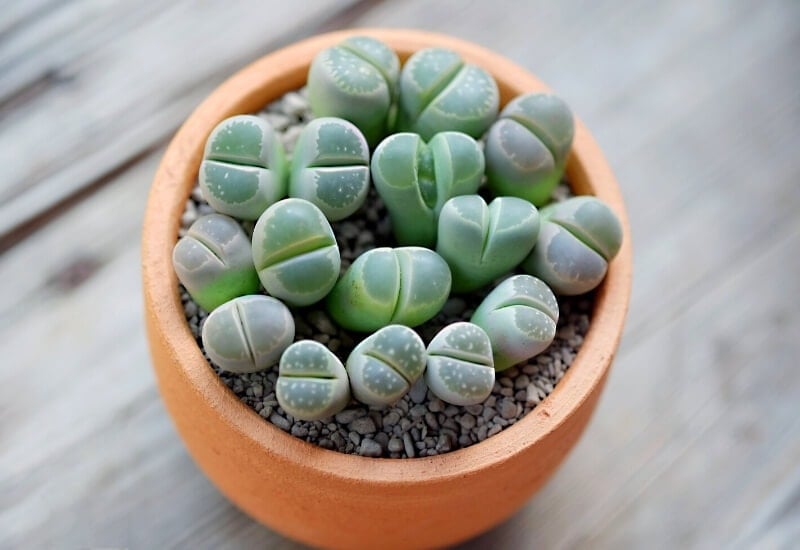
If you want a very, very small, but very, very unusual and beautiful tropical plant, choose one of the many living stone varieties. Living stone are small succulents with two fat, low and bean shaped leaves that look like stones.
There are literally hundreds of varieties, of all colors, shades and combinations. They grow very slowly, and they add a very “surreal” touch to your indoor spaces.They are perfect for terrariums and very small spaces, at eye level or near it, like low shelves, tables etc.
They look great against colored gravel; choose a contrasting color to make the best of these rock like little beauties.
10. Madagascan Palm (Pachypodium cactipes)
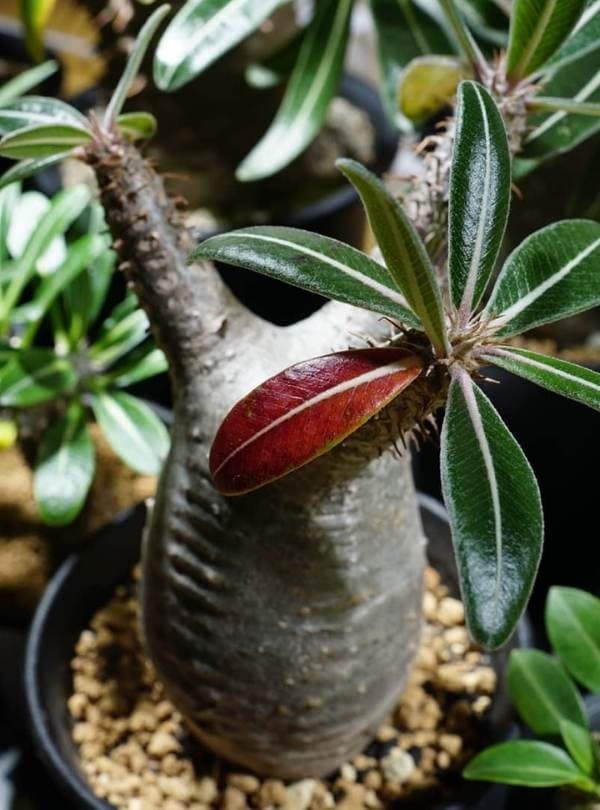
An exotic, desert looking houseplant is Madagascan palm. It has a very dry looking small trunk, that bulges at the base and then it divides into branches of a bright gray color and filled with spikes.
Then, at the end of the branches, you get just a few green oval leaves with a clear rib in the middle, that look a bit like olive leaves. Then, disproportionate bright lemon yellow flowers with five petals, of a shape similar to periwinkle will bring light and energy to this plant. On the whole, this looks like a “Jurassic plant”.
It is an excellent plant for a well lit room, like a living room or a bright kitchen. It looks great on coffee tables, but also as a centerpiece or to bring a touch of “prehistoric look” to your indoor spaces.
11. Silver Vase Bromeliad (Aechmea fasciata)
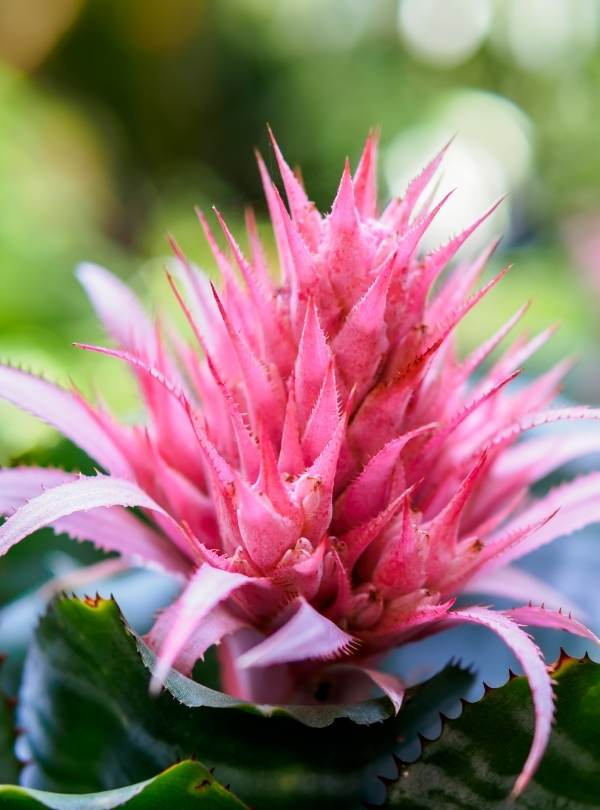
I could not miss an en exotic looking bromeliad in the list and I chose silver vase. This bromeliad has the typical rosette shaped leaves and central modified and brightly colored central leaves.
But this variety has very sturdy looking off gray leaves, very much like a cactus in texture, with a light dust on them and horizontal stripes. The central leaves are of a very bright and vivid pink color.
It looks more “permanent” and sculptural than other varieties.This bromeliad adapts to both the forest, wet look of tropical corners in a room and to the “desert and cactus” look, which too has a very exotic appeal.
12. New Guinea Shield, a.k.a. Hardy Elephant’s Ears (Alocasia wentii)
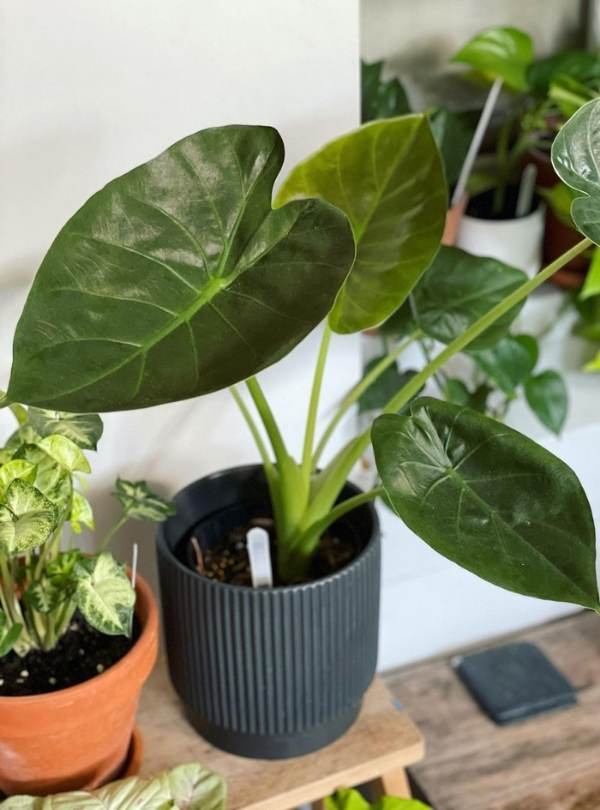
New Guinea shield is a very architectural and sculptural tropical indoor plant. Also called hardy elephant’s ears, it will produce a few stems that, from the soil, will grow vertically.
Each stem will have a broad and pointed, waxy and fleshy looking leaf, The leaves can be horizontal or point down at an angle. They look like they are made of shiny plastic or jade.
They also have waved edges and bumps in the leaf, like artistic low and high relief work.It is excellent for a super sculptural and super exotic look. It can be a centerpiece but it also mixes well with other “rain forest looking” plants, like philodendron etc.
13. Fiddle Leaf Fig (Ficus lyrata ‘Bambino’)
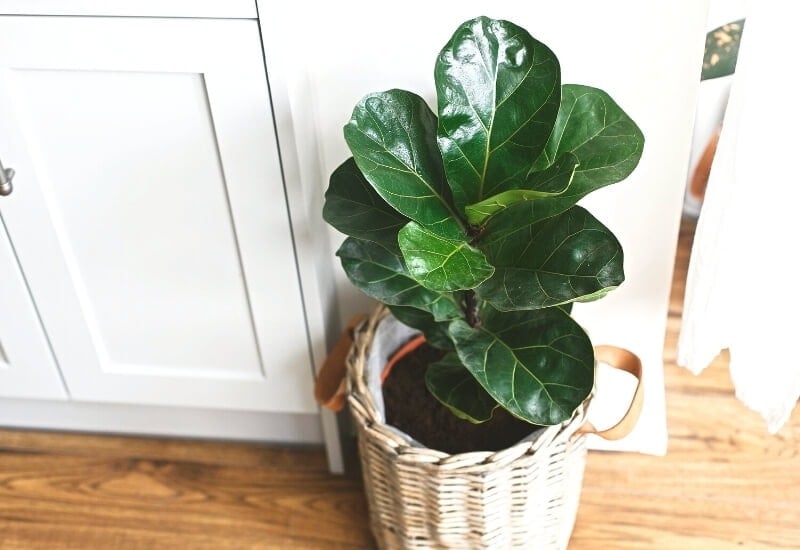
An original, large tropical plant for big indoor spaces is fiddle leaf fig. It has broad, rounded and very shiny leaves that grow along the branches. Each leaf can reach 18 inches in length (45 cm) and they have a leathery texture.
They usually have a narrowing in the middle, so they look like violins (fiddles). This plant would look great in the hall of a very luxurious hotel.
Maybe in the corridors of some big palace or important offices, and of course, in a very elegant and spacious living room. This is, only if you want a super exotic presence in your room.
14. Golden Cane Palm (Dypsis lutescens)
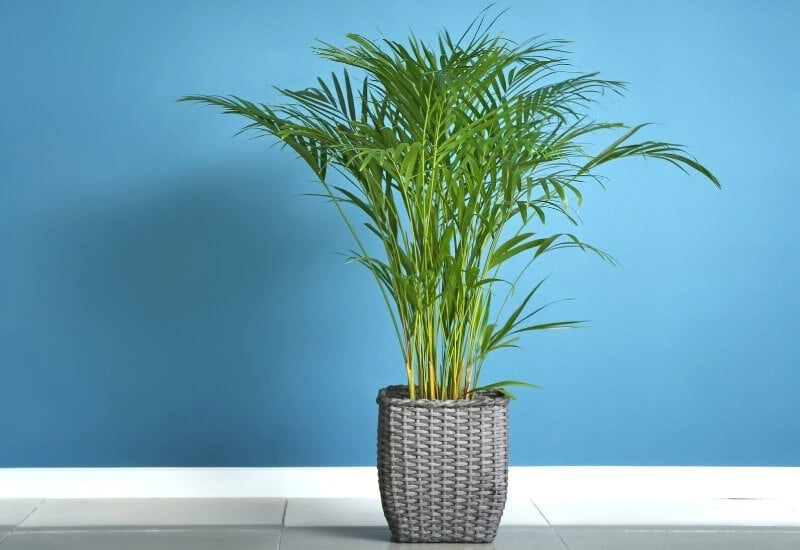
For an exotic, even “colonial” looking tropical houseplant let me propose golden cane palm. This classical looking palm with segmented (actually pinnate) fronds of the brightest green shade and very decorative texture has the “oasis” look as well as the “desert” look, but also the “rainforest” look and the “Jurassic look”.
It is a perfect plant for many types of indoor environments. It would look its best in a Victorian conservatory with wicker armchairs, but also in a modern room, its highly decorative fronds can be a real asset.
15. Thatch Palm (Howea forsteriana)
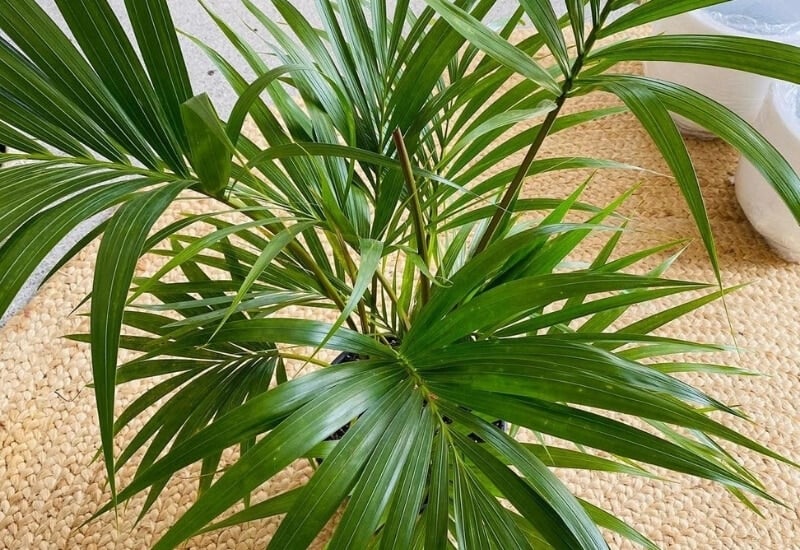
Thatch palm, or kentia palm, is one of the most “rain forest looking” plants you can grow at home. It has beautiful fan shaped fronds that grow on upright stems, but then they bend down as they mature.
The color of the foliage is deep green, and they are very glossy and “sharp” looking, like a kind of prehistoric wild grass. They can grow to become very big and showy indeed, so, this is a very “luxurious” houseplant.You can grow it on its own and it would fit in any kind of room.
But thatch palm is excellent if you have an exotic “green corners”, as it helps blend in the other plants with its rich foliage which is also delicate in texture at the same time.
Turn Your Hone into a Tropical Forest
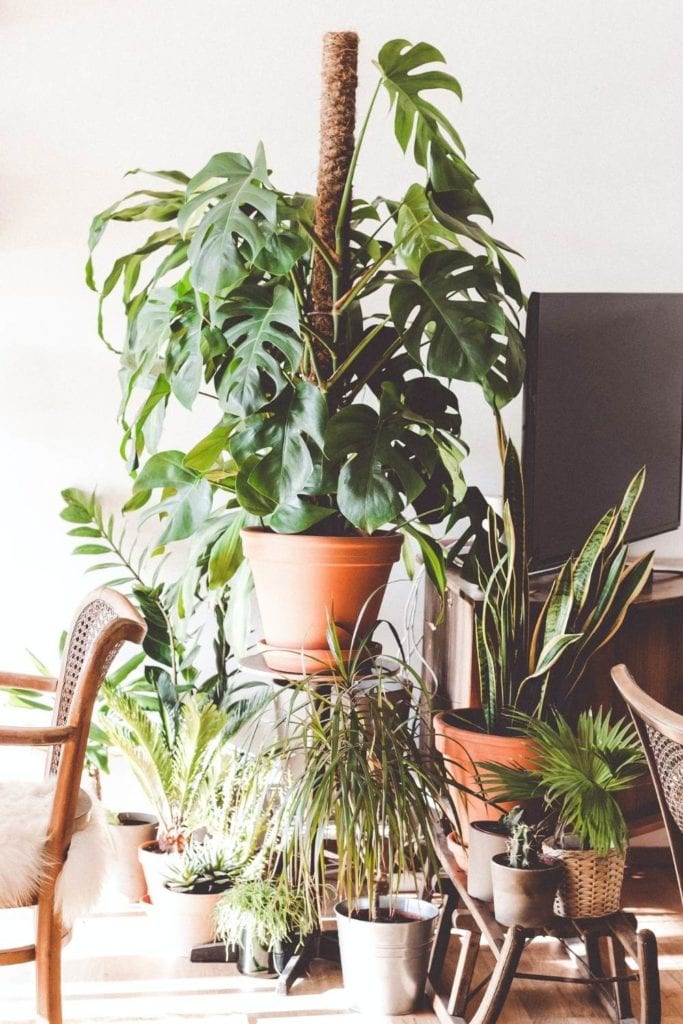
Have you seen how many stunning (and even unusual) tropical houseplants there are? There are even more, of course, but you will agree with me that these are just striking.
And if you want, you have enough of tall and short, green and colorful plants to turn a whole room in your home into a little exotic looking tropical forest!

Written By
Adriano Bulla
After many years as an academic in London, Adriano Bulla became a writer, publishing books like A History of Gardening, Organic Gardening and Elements of Garden Design; he then decided to become a gardener, following his childhood dream, and has been following his dream writing and gardening professionally in Southern Europe, where he has specialized in new and innovative organic gardening fields and techniques, like permaculture, regenerative agriculture, food forests and hydroponics.

Great recommendations! Red Coral is now on my “must buy” list. Thanks!